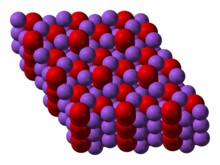Sodium Hydroxide And Hydrogen Peroxide
 | |
 | |
 | |
| Names | |
|---|---|
| Other names Disodium dioxide | |
| Identifiers | |
| CAS Number |
|
| 3D model (JSmol) |
|
| ChemSpider |
|
| ECHA InfoCard | 100.013.828 |
| EC Number |
|
| PubChem CID |
|
| RTECS number |
|
| UNII |
|
| Un number | 1504 |
| CompTox Dashboard (EPA) |
|
| InChI
| |
| SMILES
| |
| Properties | |
| Chemical formula | Na2O2 |
| Tooth mass | 77.98 g/mol |
| Advent | yellow to white powder |
| Density | 2.805 g/cm3 |
| Melting point | 460 °C (860 °F; 733 K) (decomposes) |
| Boiling point | 657 °C (one,215 °F; 930 1000) (decomposes) |
| Solubility in water | Reacts |
| Solubility | Soluble in acid Insoluble in base of operations Reacts with ethanol |
| Magnetic susceptibility (χ) | −28.ten·x−half dozen cm3/mol |
| Structure | |
| Crystal structure | hexagonal |
| Thermochemistry | |
| Rut capacity (C) | 89.37 J/(mol·K) |
| Std molar | 95 J/(mol·K)[1] |
| Std enthalpy of | −515 kJ·mol−1 [1] |
| Gibbs free energy (Δf G ⦵) | −446.9 kJ/mol |
| Hazards | |
| Occupational rubber and health (OHS/OSH): | |
| Main hazards | caustic |
| GHS labelling: | |
| Pictograms |   |
| Signal discussion | Danger |
| Take a chance statements | H271, H314 |
| Precautionary statements | P210, P220, P221, P260, P264, P280, P283, P301+P330+P331, P303+P361+P353, P304+P340, P305+P351+P338, P306+P360, P310, P321, P363, P370+P378, P371+P380+P375, P405, P501 |
| NFPA 704 (fire diamond) | 3 0 2 |
| Flash bespeak | Non-flammable |
| Safety data sheet (SDS) | External MSDS |
| Related compounds | |
| Other cations | Lithium peroxide Potassium peroxide Rubidium peroxide Caesium peroxide |
| Related sodium oxides | Sodium oxide Sodium superoxide Sodium ozonide |
| Related compounds | Sodium hydroxide Hydrogen peroxide |
| Except where otherwise noted, information are given for materials in their standard state (at 25 °C [77 °F], 100 kPa). Infobox references | |
Sodium peroxide is an inorganic chemical compound with the formula NaiiOii. This xanthous solid is the product of sodium ignited in excess oxygen.[3] It is a strong base. This metal peroxide exists in several hydrates and peroxyhydrates including Na2Oii·2H2O2·4HtwoO, Na2Otwo·2H2O, NatwoO2·2H2O2, and Na2O2·8HiiO.[iv] The octahydrate, which is simple to prepare, is white, in contrast to the anhydrous material.[5]
Properties [edit]
Sodium peroxide crystallizes with hexagonal symmetry.[6] Upon heating, the hexagonal form undergoes a transition into a phase of unknown symmetry at 512 °C.[7] With further heating above the 657 °C boiling bespeak, the compound decomposes to Na2O, releasing O2.[eight]
- 2 Na2O2 → ii NaiiO + O2
Training [edit]
The octahydrate is produced by treating sodium hydroxide with hydrogen peroxide.[5]
Sodium peroxide can exist prepared on a large calibration by the reaction of metallic sodium with oxygen at 130–200 °C, a process that generates sodium oxide, which in a dissever stage absorbs oxygen:[7] [nine]
- iv Na + Oii → 2 Na2O
- 2 NatwoO + Otwo → 2 NatwoOtwo
It may besides be produced by passing ozone gas over solid sodium iodide inside a platinum or palladium tube. The ozone oxidizes the sodium to form sodium peroxide. The iodine tin be sublimed by balmy heating. The platinum or palladium catalyzes the reaction and is not attacked by the sodium peroxide.
Uses [edit]
Sodium peroxide hydrolyzes to give sodium hydroxide and hydrogen peroxide according to the reaction[nine]
- Na2Otwo + 2 HiiO → 2 NaOH + H2Otwo
Sodium peroxide was used to bleach forest pulp for the production of paper and textiles. Soon it is mainly used for specialized laboratory operations, e.k., the extraction of minerals from various ores. Sodium peroxide may go past the commercial names of Solozone [vii] and Flocool.[viii] In chemical science preparations, sodium peroxide is used as an oxidizing agent. It is also used as an oxygen source by reacting it with carbon dioxide to produce oxygen and sodium carbonate:
- ii Na2O2 + two CO2 → 2 Na2CO3 + Otwo
It is thus specially useful in scuba gear, submarines, etc. Lithium peroxide and potassium superoxide accept similar uses.
References [edit]
- ^ a b Zumdahl, Steven Southward. (2009). Chemic Principles 6th Ed. Houghton Mifflin Company. p. A23. ISBN978-0-618-94690-vii.
- ^ "Hazard Rating Information for NFPA Burn Diamonds". Archived from the original on 2004-09-04.
- ^ Greenwood, Norman N.; Earnshaw, Alan (1984). Chemistry of the Elements. Oxford: Pergamon Press. p. 98. ISBN978-0-08-022057-four.
- ^ Harald Jakob, Stefan Leininger, Thomas Lehmann, Sylvia Jacobi, Sven Gutewort. "Peroxo Compounds, Inorganic". Ullmann'south Encyclopedia of Industrial Chemistry, 2007, Wiley-VCH, Weinheim. doi:ten.1002/14356007.a19_177.pub2.
- ^ a b R. A. Penneman (1950). "Potassium Sodium Peroxide 8-Hydrate". Inorg. Synth. 3: ane–4. doi:10.1002/9780470132340.ch1.
{{cite journal}}: CS1 maint: uses authors parameter (link) - ^ Tallman, R. L.; Margrave, J. 50.; Bailey, Due south. W. (1957). "The Crystal Structure Of Sodium Peroxide". J. Am. Chem. Soc. 79 (eleven): 2979–fourscore. doi:10.1021/ja01568a087.
- ^ a b c Macintyre, J. E., ed. Dictionary of Inorganic Compounds, Chapman & Hall: 1992.
- ^ a b Lewis, R. J. Sax'due south Dangerous Backdrop of Industrial Materials, 10th ed., John Wiley & Sons, Inc.: 2000.
- ^ a b Eastward. Dönges "Lithium and Sodium Peroxides" in Handbook of Preparative Inorganic Chemistry, 2nd Ed. Edited by Chiliad. Brauer, Academic Press, 1963, NY. Vol. ane. p. 979.
External links [edit]
- International Chemical Prophylactic Card 1606
Sodium Hydroxide And Hydrogen Peroxide,
Source: https://en.wikipedia.org/wiki/Sodium_peroxide
Posted by: hillpoetastords1990.blogspot.com



0 Response to "Sodium Hydroxide And Hydrogen Peroxide"
Post a Comment